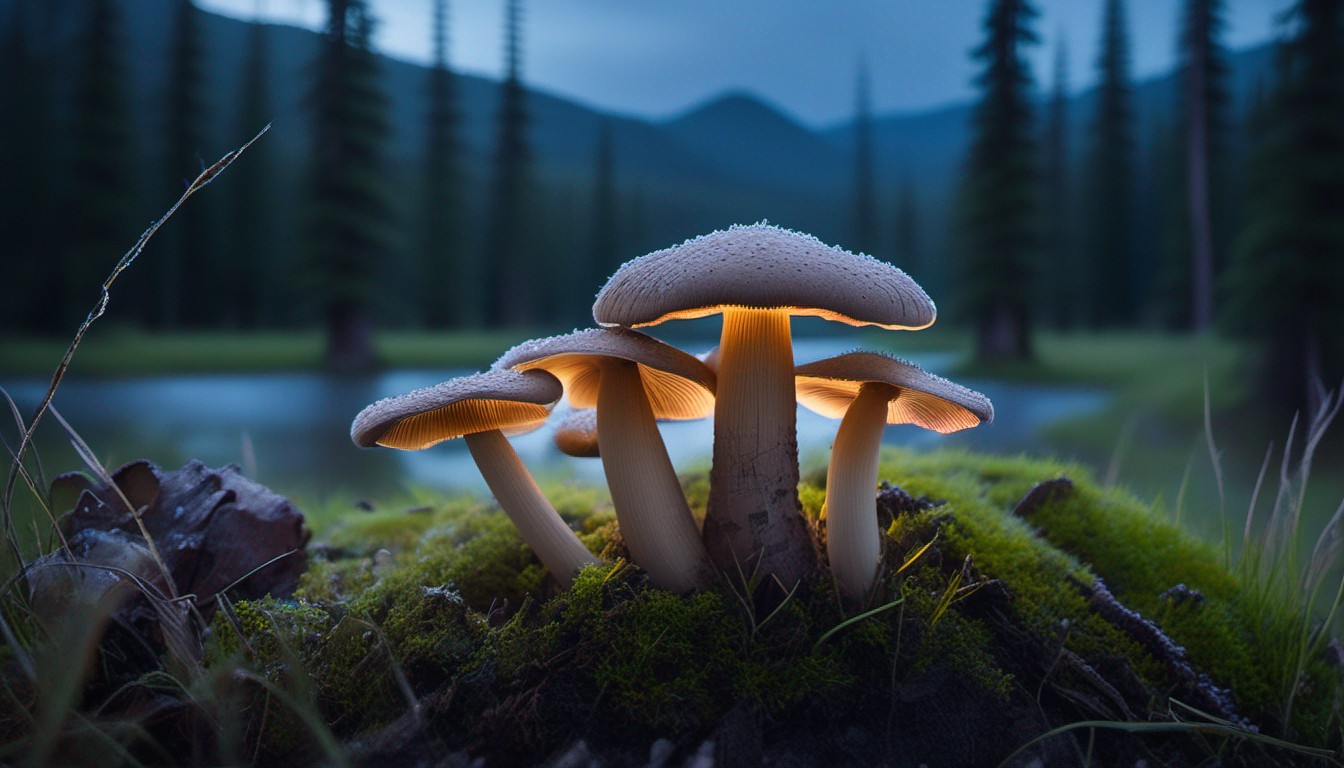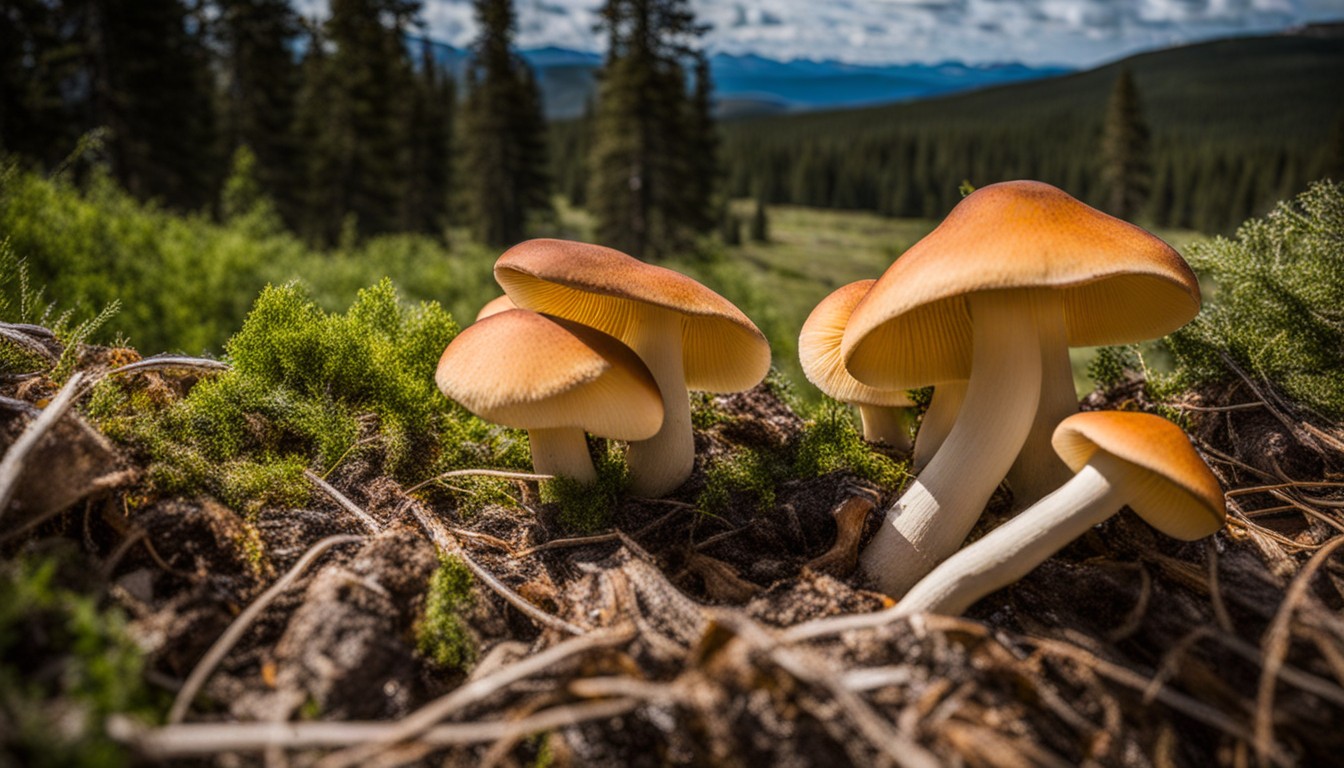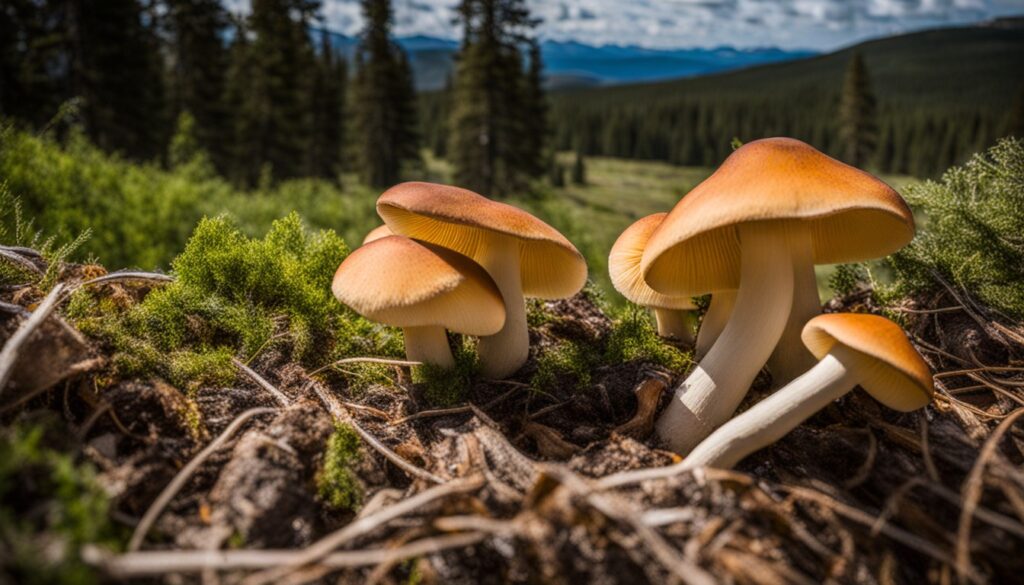Mushrooms in Portugal: A Guide to the Fungi of the Iberian Peninsula is a comprehensive and detailed resource for mushroom enthusiasts and nature lovers. This informative blog post explores the rich diversity of mushrooms found in Portugal, highlighting their unique characteristics, habitat preferences, and culinary uses. From coastal regions to mountainous landscapes, readers will discover the wide variety of mushroom species that thrive in this beautiful country. Whether you’re a seasoned forager or simply curious about the fascinating world of fungi, this guide will provide valuable insights and practical tips for mushroom hunting in Portugal. So grab your basket and get ready to embark on an exciting adventure through the enchanting forests of the Iberian Peninsula.
The Diversity of Fungi in Portugal
Portugal’s ecosystem is a treasure trove teeming with a diverse variety of fungi. The richness of fungal species not only adds to the country’s natural biodiversity but also plays an essential role in maintaining the balance of its vibrant ecosystems.
Portugal’s vast fungal diversity contributes significantly to its ecological balance, strengthening nutrient cycling, decomposition processes, and supporting plant life.
Fungi fulfill pivotal roles within Portugal’s biological fabric. From decomposition and nutrient cycling to mutualistic partnerships with plants, their invaluable contribution underpins the functionality and continuity of life in the country’s biodiverse landscapes.
Introduction to the Fungal Species in Portugal
Portugal is home to an extensive variety of fungi, with a vast array of mushroom species that adorn its landscapes. This diversity illuminates the country’s rich ecosystem, offering a fascinating insight into the realm of mycology – the study of fungi.
A notable characteristic of Portugal’s fungi diversity lies in its range of both edible and poisonous species. An understanding of common fungi species in Portugal is the first step to delve into the art of mushroom hunting.
Armed with a guide to identifying these species, enthusiasts and experts alike can engage in foraging activities with added confidence and caution. Such a guide becomes an invaluable tool in differentiating between a delightful meal option and a dangerous look-alike.
Common Edible Mushrooms in Portugal
The variety of edible mushrooms in Portugal presents a culinary gateway to understanding the nation’s cuisine. Accurate identification and sustainable harvesting of these fungi from local forests ensure an enriching from-forest-to-plate experience.
- Tricholoma equestre: Also known as Yellow Knight, commonly used in traditional Portuguese dishes
- Agaricus bisporus: Widely known as the Button Mushroom, cultivated and consumed globally
- Boletus edulis: Known as King Bolete, these mushrooms are prized for their rich flavor
- Amanita caesarea: Commonly called Royal Mushroom, a highly sought-after delicacy
- Morchella esculenta: Known as Morel, a gourmet mushroom species demanding a high market price
- Cantharellus cibarius: Also known as Chanterelle, features in timeless Portuguese recipes
Poisonous Mushrooms to Avoid
The spectacular biodiversity of mushrooms in Portugal does not come without its perils, particularly with the existence of deadly fungi. Knowledge of these hazardous species is essential for a safe foraging experience.
- Amanita Phalloides: Known as the Death Cap, ingesting it can be fatal.
- Amanita Muscaria: Also called Fly Agaric, it is psychoactive and can cause severe physical discomfort.
- Amanita Pantherina: Commonly known as the Panther Cap, its toxins can induce hallucinations and other distressing symptoms.
- Cortinarius Orellanus: Referred to as Fool’s Webcap, long term kidney damage can result from ingestion.
- Inocybe patouillardii: A rare species, however, contains muscarine which can lead to serious poisoning.
The Mushroom Season in Portugal

Embracing the fungus bloom, Portugal comes alive with mushroom diversity during the fall season, offering an exciting foray for mushroom enthusiasts. This period witnesses an increase in humidity and rainfall that creates an ideal environment for fungal growth.
Mushroom farming cycles in Portugal are a testament to the rhythm of nature. These saprophytic organisms, depending on the species, fruit either in autumn, following the rains, or in spring, consuming the decaying organic matter of the previous year.
Understanding the Mushroom Growing Cycle
In the heart of Portugal’s woodlands, a microscopic miracle ensues: the fungi life cycle. This intricate process begins with the release of spores from a mature fungus, initiating a captivating reproduction sequence unseen by the naked eye.
These minute spores, scattered by wind or rain, eventually find a suitable substrate where they germinate and grow into hyphae – the fungal equivalent of roots. Over time, these hyphae intertwine to form a network known as mycelium.
Major environmental shifts, such as temperature and rainfall changes, stimulate the mycelium to form a fruiting body – the part we recognize as a mushroom. This heralds the mushroom season in Portugal, an event widely anticipated by foragers.
The fungal life cycle is more than a fascinating natural phenomenon; it’s a crucial shaper of the Iberian ecosystem. By decomposing organic matter and returning nutrients to the soil, fungi enhance plant growth and contribute to the biodiversity.
Moreover, certain fungus species establish symbiotic relationships with trees, a factor vital for the survival of Portugal’s woodlands. Hence, understanding the mushroom growing cycle is not only essential for foraging but for recognizing the importance of fungi in our environment as well.
Best Time to Hunt Mushrooms in Portugal
Mushroom foraging in Portugal aligns with seasonal rhythms, beginning in earnest in the cool, damp months of autumn. Profuse in forests, the fungi offer a bountiful treasure for those versed in their varying appearances.
December to February constitute the prime months for mushroom hunting in the Iberian Peninsula. The ideal blend of temperature and rainfall during this period encourages mycelium growth, leading to a widespread fruiting of mushrooms.
A keen understanding of Portugal’s mushroom calendar aids foragers in knowing when specific favorite species appear. For instance, the beloved and edible Boletus edulis thrives in fall months.
Summer months provide a lull in the mushroom bounty. Most species retreat, hiding underground while awaiting the composting effects of autumn’s fallen leaves. However, careful observers might still spot sporadic growths.
Foragers should remember that Portugal’s mushroom seasons can be influenced by yearly weather variations. Therefore, staying updated with local weather patterns will give the best chances for a successful foraging expedition.
Popular Mushroom Species in the Iberian Peninsula
Across Portugal and Spain, the Iberian Peninsula plays host to a diverse range of fungi, with some species found only within this region, truly making them a natural treasure of the peninsula.
With specialties like the Amanita Caesarea, Boletus Edulis, Cantharellus Cibarius, Lactarius Deliciosus, and the Suillus Luteus, Portugal adds uniquely to the fungal richness of the Iberian Peninsula.
Amanita Caesarea: The Royal Mushroom
Delving into the legacy of the Amanita Caesarea, it’s clear to see why it’s dubbed Portugal’s Royal Mushroom. Esteemed since ancient Roman times, its majestic stature and vibrant hues command respect among mycologists and nature enthusiasts alike.
It flourishes amid Portugal’s deciduous forests, locked in a symbiotic relationship with oak and chestnut trees. Its fruiting bodies erupt from the earth from summer through autumn, boasting a stunning red-orange cap, deeply suggestive of a flamboyant royal cloak.
The tale of Amanita Caesarea’s rise to nobility is indeed captivating. Named after Emperor Caesar for his fondness of the mushroom, it became a symbol of luxury, often reserved for the aristocracy during Roman Empire.
Today, it stands beyond just a symbol, admired for its delicate flavor. The epicureans across the Iberian peninsula value it for its deep, rich aroma and the subtle sweetness it lends to culinary delicacies.
Yet, caution is urged when hunting this royal treasure. Paradoxically, it shares the genus ‘Amanita’ with some of the world’s most lethal mushrooms. Proper identification thus remains crucial to safely enjoy Amanita Caesarea’s regal delights.
Boletus Edulis: The King Bolete
Deeply revered in Portugal is the Boletus Edulis, commonly known as the King Bolete. A regal presence in the diverse world of Iberian fungi, it elicits respect from foragers, chefs, and mushroom enthusiasts alike.
Regarded as Portugal’s regal delicacy, the King Bolete is renowned for its rich flavor and robust structure. This edible specimen offers a captivating culinary experience, setting the Portuguese gastronomy scene ablaze through its versatility and delicate earthy undertones.
One must tread lightly in the thick woods during the mushroom season, for the King Bolete’s cap and stalk ascend from the fertile ground. The joy of spotting it is a cherished event marking an important foraging milestone in Portugal.
Cantharellus Cibarius: The Chanterelle
The Cantharellus Cibarius, commonly referred to as the Chanterelle, thrives remarkably well within the deciduous and coniferous forests of Portugal. Its distinctive funneled cap and fruity aroma make it highly distinguishable amid the forest litter.
Recognized as an epicurean delight, the Chanterelle impresses not just with its flamboyant golden color but also its exquisite taste, accentuating the vivid flavors of Iberian cuisines with its peppery and slightly fruity notes.
Regarded as the culinary gold of Iberian Peninsula’s mycology, Cantharellus Cibarius forms a vital inclusion in various Portuguese dishes, ensuring its demand by connoisseurs of gourmet fungus.
Lactarius Deliciosus: The Saffron Milk Cap
A magnet for mushroom foragers, the Lactarius Deliciosus, fondly referred to as the Saffron Milk Cap, bestows an enticing allure due to its unique taste and texture. Its vibrant orange cap, coupled with a large, exuberant body, promises a culinary experience like no other.
Renowned for its meek, yet discernible sweet taste, it brings to mind the raw simplicity of Portugal’s verdant forests. Conversely, its texture presents a firm resilience, adding substance and depth to any culinary creation.
The name ‘Deliciosus’ is no exaggeration. This esteemed fungus from Portugal’s forests belies a mesmerizing sweet nectar. A vivid reminder of nature’s diverse palate of flavors, it delivers an earthy sweetness, unlike any other mushroom.
This natural produce, sourced from Portugal’s wild forests, encapsulates the essence of the region’s terrain through its sweet sap and alluring flavor. Undoubtedly, the Lactarius Deliciosus holds a revered place in Portugal’s mythos of indigenous mushrooms.
Suillus Luteus: The Slippery Jack
Enshrouded in its spongy, slimy cap, the Slippery Jack or Suillus Luteus is common in Portugal’s coniferous forests. It’s known for its light yellow-brown color, distinctive ring on the stipe, and, notably, the ‘slippery’ texture when it’s humid.
In Portuguese gastronomy, the Slippery Jack can be an edible marvel, if cautiously prepared. Before consuming, it’s crucial to thoroughly peel off the sticky skin and cook it, as the raw or unpeeled mushroom may cause an upset stomach.
Despite potential toxicity, some still relish this fungi. Therefore, knowledge of preparing and cooking it safely is imperative. Through diligent preparation, this mushroom can indeed turn from a potentially toxic invader to a culinary delight.
Where to Find Mushrooms in Portugal

Portugal brims with delightful fungal finds, each region marking its unique mushroom map. From northern Portugal’s damp forests to the sunny Algarve, every landscape offers a plethora of idiosyncratic species. Yet, it’s the offbeat, lesser-trodden terrains where some of the rarest fungi thrive. Seek out the rocky outcrops, dense undergrowth, and secluded waterways for unconventional mushroom finds, rewarding you with not just a grand harvest, but the immersive experience of Portugal’s diverse biosphere
Exploring the Forests and Woodlands
Revel in the silent symphony of fungi as it echoes the rich biodiversity in Portugal’s forests and woodlands. Trill with the thrill of discovery as you spot varying mushroom species nestled amidst lush vegetation.
Engage in a wholly immersive experience in Portugal’s forests, tracing the gentle curves of different caps and testing their texture. Every mushroom patch whispers a tale woven into the very fabric of these biodiverse woodlands.
Step into surreal scenery as you participate in mushroom foraging amidst woodland flora. This activity is much more than a fun pastime, it’s a journey into Portugal’s unique and intricate eco-system, enriched by a spellbinding array of mushroom species.
Mushroom Hotspots in Portugal
A mushroom enthusiast’s dream, Portugal brims with fungal diversity. Alentejo, Algarve, and Trás-os-Montes regions are noteworthy destinations, rich in species like Boletus, Amanita, and Cantharellus.
Apart from these, the secret trails in the heartland of Portugal such as Serra da Estrela and Peneda-Gerês National Park reveal a treasure trove of fungal biodiversity.
For rare species like the Lactarius Deterrimus or the exotic Auriscalpium vulgare, the natural woodlands of Madeira and Azores archipelago act as fertile grounds.
Urban parks in cities like Lisbon and Porto also offer unexpected mushroom delights, expanding the adventure avenues for passionate mushroom foragers.
Foraging Tips and Safety
Unlocking the bounty of Portugal’s wild mushrooms requires knowledge and practice. Accurate identification, understanding fungi habitats, and knowing the right season for each species are key. It’s thrilling to find a wild mushroom, yet not every mushroom found should be taken home.
Strict safety measures should guide your fungi collection in Portugal. Always accurately identify mushrooms before consumption – mistakes can be fatal. Consuming locally foraged mushrooms? Ensure they are thoroughly cooked. Some mushrooms contain harmful bacteria, and cooking kills these. For sustainable foraging, leave small, young mushrooms and only pick what you need.
Identification Techniques for Mushroom Hunters
Nature paints a vivid picture with nuanced clues, and deciphering these signals is integral to mushroom identification. Portugal’s diverse fungal species, therefore, demand keen observation and knowledge in decoding these nature’s cues.
The visual language of mushrooms is complex. Yet, understanding its vocabulary is key to identifying the varied species found across the Iberian Peninsula. Basics include the cap’s color, gill structure, stipe characteristics, and spore print.
A gentle approach, patience and consistent practice can enhance your identification skills. Pairing this with knowledge gathered from local experts and field guides will equip you to distinguish between the subtly different characteristics of Portugal’s mushrooms.
Safety Precautions When Collecting Mushrooms
Navigating mushroom foraging risks in Portugal beckons a profound comprehension of the local flora. Vigilance and a well-researched field guide are critical to avoid accidental ingestion of toxic species.
Portuguese mushroom hunting, despite its enchantment, entails cautionary tales. Distinguishing between look-alike species, avoiding mushrooms growing near polluted areas, and promptly cooking harvested edibles are precautions one must never ignore.
Sustainable Foraging Practices
In Portugal, savvy mushroom foragers prioritize sustainable practices, understanding that indiscriminate harvesting can devastate fungal populations. They’re conscious of preserving the fungi’s habitats, collecting only mature specimens and leaving the young ones to ensure future growth.
Harvesting with intent preserves the intricate web of life in the fungi world. It means taking the time to identify each species before picking, pruning them carefully, and keeping the collection limited to one’s needs, favoring a take-some, leave-some approach.
The Emerald Greens, a network of mushroom enthusiasts in Portugal, actively promotes sustainable mushroom hunting. Through education and advocacy, they work to preserve the vast and varied fungal biodiversity of the Iberian Peninsula.
Their efforts highlight the importance not only of respecting nature and its resources but also of spreading awareness. The shared responsibility resonates with urban mushroom hunters and rural communities alike, fostering a culture of sustainable wild harvest in Portugal.
FAQ: Mushrooms in Portugal
Welcome to the FAQ section of “Mushrooms in Portugal: A Guide to the Fungi of the Iberian Peninsula.” This FAQ aims to provide concise answers to common questions about mushroom foraging and identification in Portugal.
1. What types of mushrooms can be found in Portugal?
Portugal boasts a rich variety of mushroom species, including boletes, chanterelles, milkcaps, amanitas, and more. From coastal regions to mountainous areas, the diverse ecosystems of Portugal provide a fertile ground for mushroom growth and diversity.
2. Are there any poisonous mushrooms in Portugal?
Yes, Portugal is home to several species of poisonous mushrooms. It is crucial to exercise caution when foraging and never consume a mushroom unless you are absolutely certain of its identity. Consult reputable field guides or seek the guidance of knowledgeable experts in mycology.
3. Can I legally harvest wild mushrooms in Portugal?
In Portugal, harvesting wild mushrooms for personal use is generally permitted. However, it is important to familiarize yourself with regional regulations and restrictions. For commercial harvesting, a permit is required. Always prioritize sustainable foraging practices and avoid over-harvesting.
4. Where are the best places to go mushroom hunting in Portugal?
Portugal offers a plethora of regions that are renowned for mushroom hunting. The Serra da Estrela, Serra de São Mamede, and Serra d’Aire e Candeeiros are just a few examples of areas that provide diverse habitats and a wide range of mushroom species. Consider joining local mycological associations or hiring experienced guides to maximize your mushroom hunting experience.
5. How can I identify edible mushrooms in Portugal?
Correctly identifying edible mushrooms requires knowledge and experience. It is advisable to consult reputable field guides specifically focused on mushrooms in Portugal. Attending workshops, joining forays, or connecting with local mycological associations can also enhance your identification skills. Always cross-reference multiple sources and be aware of potential look-alike species.
6. What are the best ways to preserve and cook mushrooms?
To preserve mushrooms, popular methods include drying, freezing, or pickling. Dry mushrooms in a well-ventilated area or using a dehydrator to remove moisture. Freezing mushrooms requires blanching them briefly before freezing in airtight containers. Pickling mushrooms in vinegar brine is another excellent preservation method. When it comes to cooking, sautéing mushrooms with butter or olive oil, grilling them on skewers, or adding them to soups and stews can create delightful culinary experiences. Experiment with different recipes and cooking techniques to discover your preferred preparations.
Remember, while mushroom foraging can be a rewarding and enjoyable activity, it is crucial to prioritize safety, responsible practices, and continuous learning. If you are uncertain about the identification or edibility of a mushroom, consult a mycologist or seek professional advice.
Conclusion
Portugal’s fungal kingdom is indeed a buffet of diversity and beauty. The mushrooms’ various roles in Portugal’s ecology, cuisine, and heritage underline the importance of these fungicultural treasures in the nation’s identity.
- The manifold roles of fungi in Portugal’s ecosystems.
- The contribution of mushrooms to Portuguese cuisine.
- The significance of mushrooms in Portugal’s cultural heritage.

